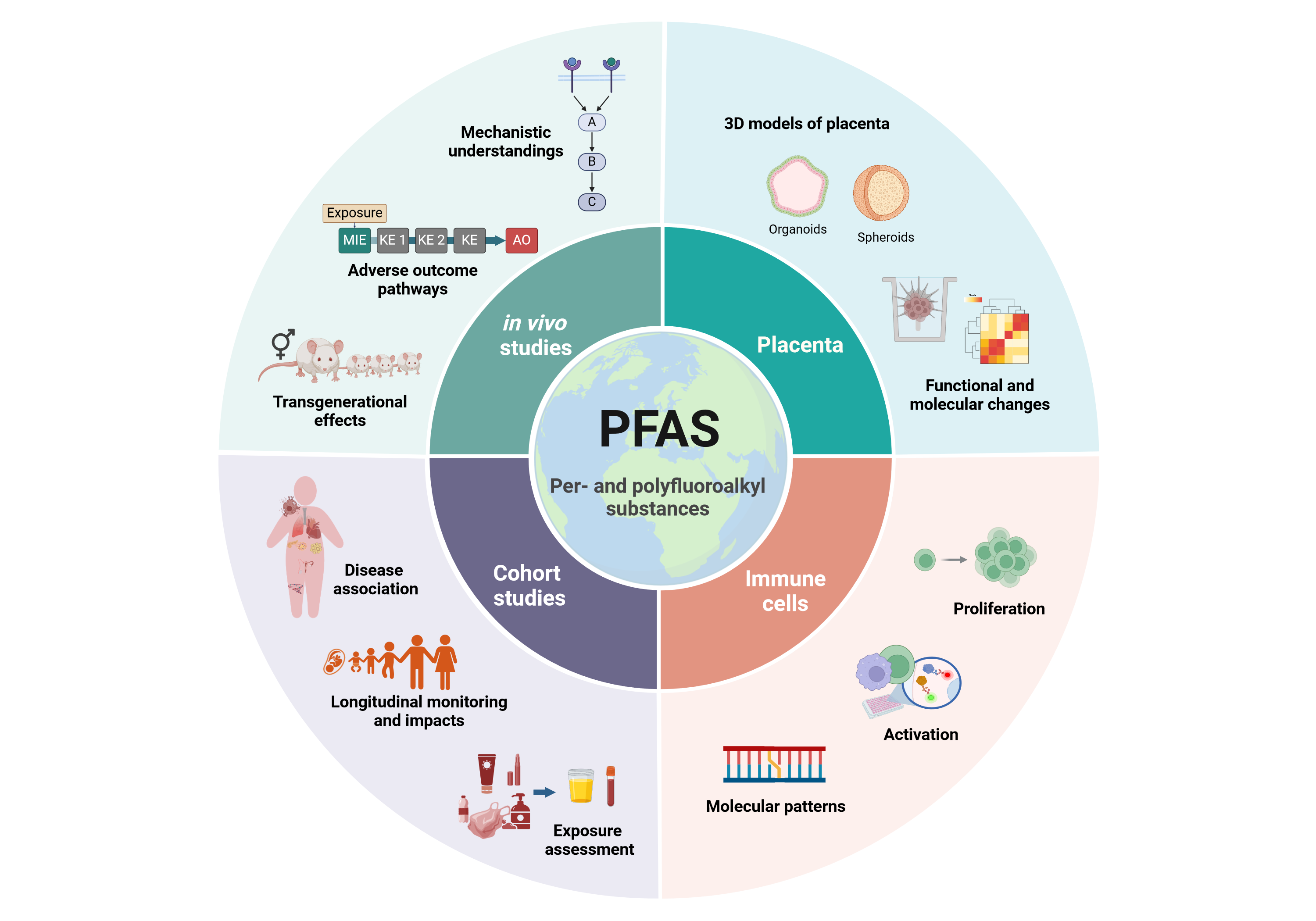PFAS

Pregnancy is a unique period of life where
changes in maternal physiology occur in order to accommodate the early life
development of the fetus. This is a very vulnerable stage to environmental
factors and the placenta, the newly formed organ in pregnancy, is responsible
for the fetal development. In that order, we are in a need of high-content,
non-animal testing that mimics faithfully the human placenta physiology to
elucidate the effects of endocrine disrupting chemicals such as PFAS on
pregnancy and early life development.
Here we develop, 3D cell culture models of placenta namely spheroids from trophoblast cell lines and organoids from primary early placental tissue that share many characteristics with human placenta in terms of morphology and physiology. Upon exposure to PFAS, several parameters are evaluated including viability, proliferation, invasion, hormone production and gene changes. Additionally, as PFAS are virtually detected in all blood samples around the globe, here we concentrate on testing the presence for PFAS in 1st trimester placenta tissue. Based on the results, we set-up a real-life PFAS exposure mixture of concern, that is later on used to test its effects on our 3D models of placenta.
Furthermore, our research department assesses effects of individual PFAS and PFAS mixtures on various primary immune cell populations. Cell toxicity, phenotypic changes, alterations in activation states as well as changes in molecular patterns are used as immunological read-outs. Immune cell changes are analysed by a battery of in vitro assays and by advanced technologies such as CYTOF. The research project is embedded in a broader research consortium within CITE and is realized with our cooperation partners from Norway.
In our in vitro immune cell-based assays, we already have shown that PFAS have an immunomodulatory capacity (Maddalon et al., 2023; Fischer et al., 2024). The next step is to analyze the relationship between PFAS, immune responses and other health outcomes at the population level. Our own longitudinal mother-child cohort LINA gives us the opportunity to analyze the impact of PFAS during pregnancy, a vulnerable period of exposure, on the developing immune system of the offspring. To this end, untargeted measurements of chemicals, including PFAS, have recently been performed in maternal samples collected during pregnancy (Braun et al., 2024). In collaboration with other cohorts (partners in the EU-funded ENDOMIX project), we aim to analyze PFAS-related health outcomes on a European scale.
- Xia Y., Fu Q., Voss H., Fest S., Zenclussen A.C., Stojanovska V. Evaluation of real-life PFAS mixture toxicity and impact on 3D placenta spheroid model. Tox Let. Vol 399S2; 2024 https://doi.org/10.1016/j.toxlet.2024.07.471
Maddalon, A., Pierzchalski, A., Kretschmer, T., Bauer, M., Zenclussen, A. C., Marinovich, M., Corsini, E., & Herberth, G. (2023). Mixtures of per- and poly-fluoroalkyl substances (PFAS) reduce the in vitro activation of human T cells and basophils. Chemosphere, 336, 139204. https://doi.org/10.1016/j.chemosphere.2023.139204
- Fischer, F., Pierzchalski, A., Riesbeck, S., Aldehoff, A. S., Castaneda-Monsalve, V. A., Haange, S. B., von Bergen, M., Rolle-Kampczyk, U. E., Jehmlich, N., Zenclussen, A. C., & Herberth, G. (2024). An in vitro model system for testing chemical effects on microbiome-immune interactions - examples with BPX and PFAS mixtures. Frontiers in immunology, 15, 1298971. https://doi.org/10.3389/fimmu.2024.1298971
- Braun, G., Herberth, G., Krauss, M., König, M., Wojtysiak, N., Zenclussen, A. C., & Escher, B. I. (2024). Neurotoxic mixture effects of chemicals extracted from blood of pregnant women. Science (New York, N.Y.), 386(6719), 301–309. https://doi.org/10.1126/science.adq0336
